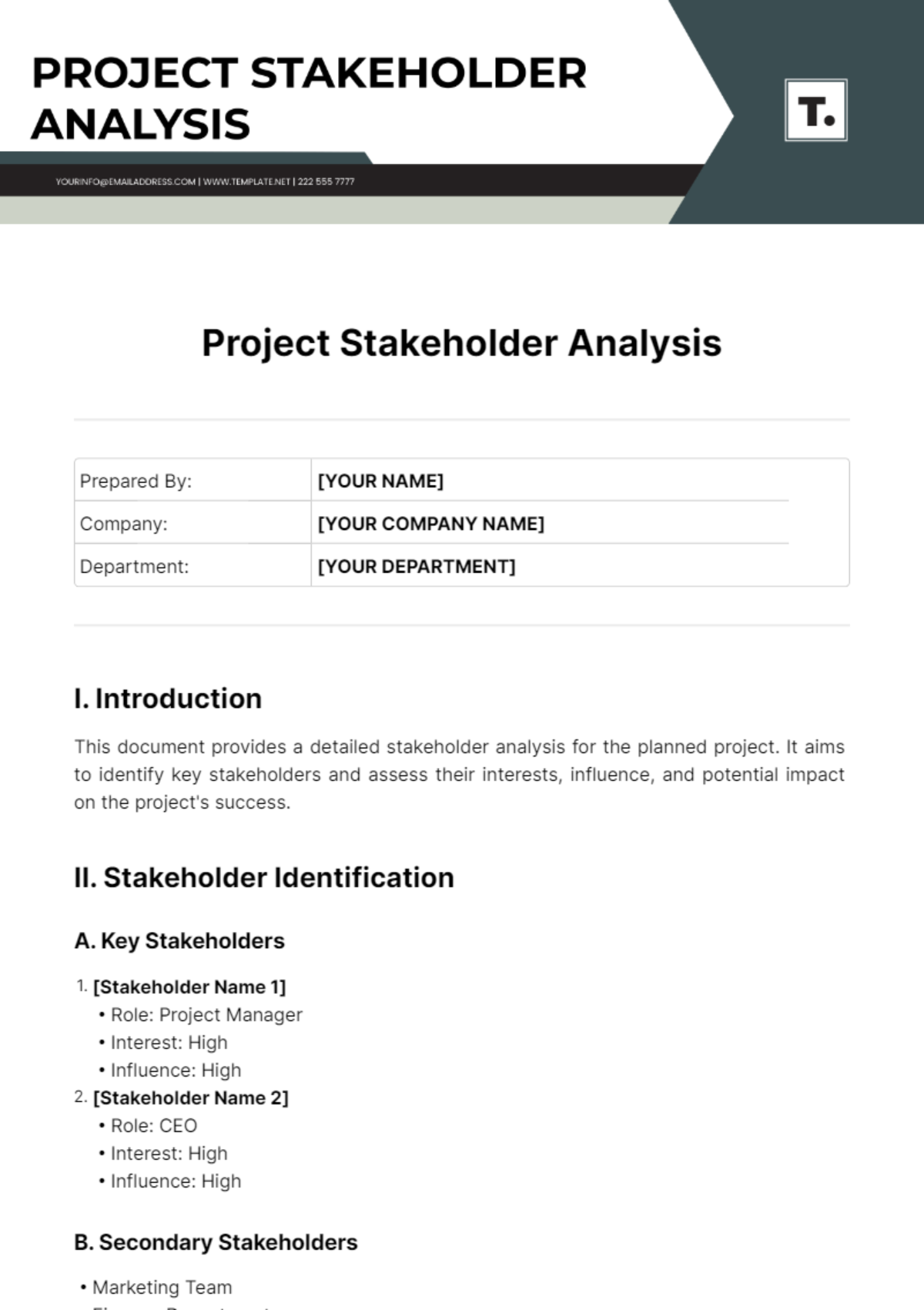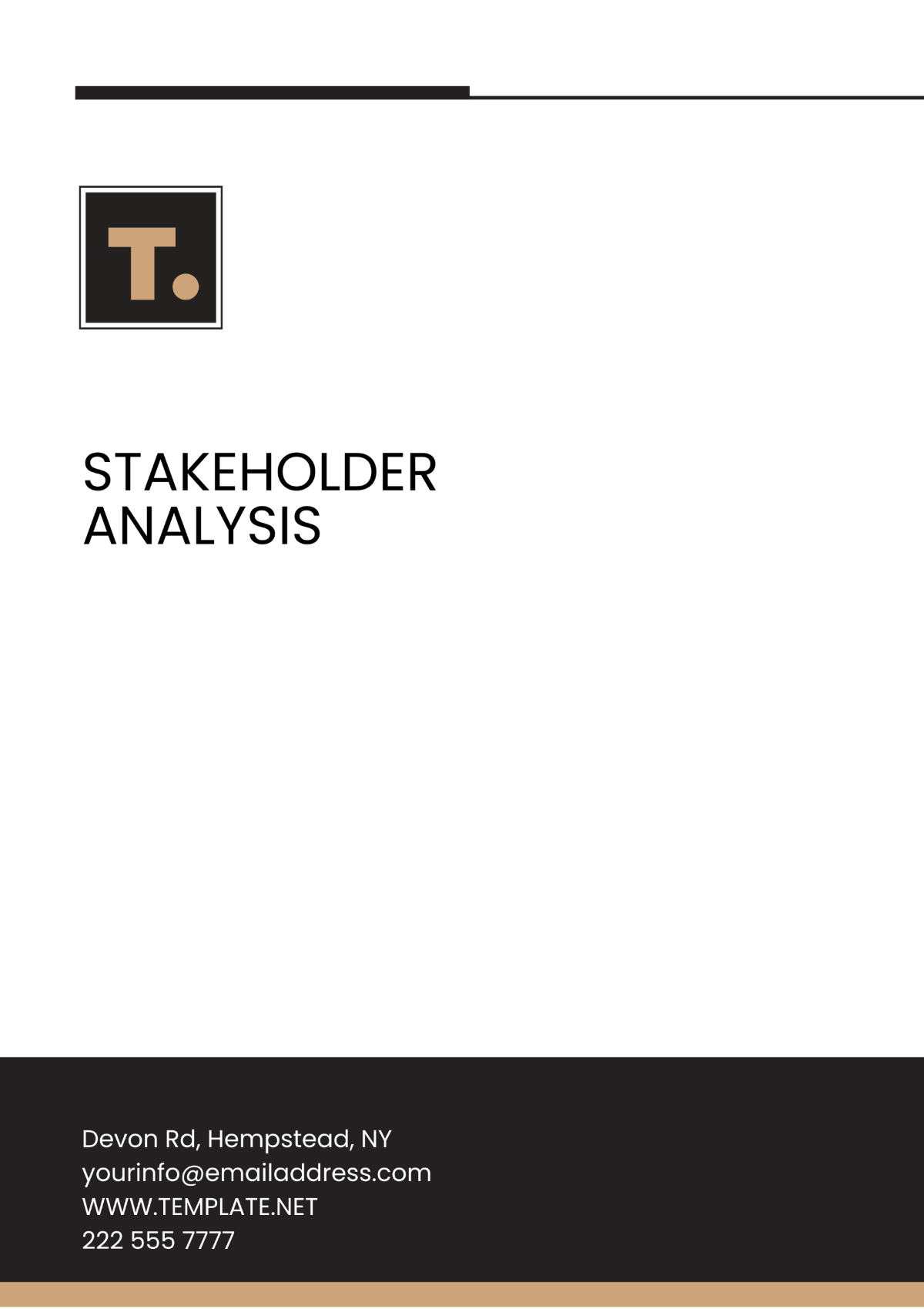Stakeholder Analysis Requirements
Prepared by: [Your Name]
Date: [Date]
I. Introduction
The Stakeholder Analysis Requirement provides a comprehensive set of guidelines, criteria, and conditions for identifying, analyzing, and prioritizing stakeholders in a project or organization. Effective stakeholder analysis ensures that stakeholders' interests, influence, and impact are thoroughly understood to enable effective communication, engagement, and decision-making throughout the project lifecycle.
II. Stakeholder Identification
The process of stakeholder identification involves a structured approach to recognizing all individuals, groups, or organizations that may affect or be affected by the project's outcomes. Accurate identification is the first step in managing stakeholder relationships effectively.
A. Steps for Identification
Review Project Documents and Objectives:
Examine project charters, proposals, and planning documents to identify initial stakeholders and understand their roles and interests.
Conduct Interviews with Key Project Members and Experts:
Engage with project team members, subject matter experts, and other relevant individuals to gather insights on potential stakeholders and their significance.
Utilize Brainstorming Sessions:
Organize brainstorming sessions with project teams to generate a comprehensive list of potential stakeholders based on their knowledge and experience.
Consult with Leadership and Advisory Committees:
Seek input from organizational leaders and advisory committees to validate stakeholder lists and identify additional key players.
Create a Comprehensive Stakeholder List and Categorize Them Accordingly:
Develop a detailed list of stakeholders, categorizing them by their role, impact, and interest in the project.
III. Stakeholder Analysis
Stakeholder analysis involves a thorough examination of each stakeholder's interests, expectations, levels of influence, and the potential impact they may have on the project. This analysis is essential for tailoring engagement strategies and addressing stakeholder needs effectively.
A. Analysis Criteria
Criteria | Description |
|---|---|
Interest | Determine what stakeholders expect to gain or lose from the project. |
Influence | Assess the level of power or influence stakeholders have in shaping project outcomes. |
Impact | Evaluate how significantly the project affects stakeholders or is affected by them. |
IV. Stakeholder Prioritization
Prioritizing stakeholders is crucial for directing resources and efforts towards those with the most significant influence or interest in the project. Effective prioritization helps in managing stakeholder relationships more efficiently.
A. Prioritization Matrix
Prioritization Category | Description | Action |
|---|---|---|
High Influence/High Interest | Key Players: Engage these stakeholders closely and manage their involvement actively. Their support is critical for project success. | Actively involve in decision-making and updates. Address their needs and concerns promptly. |
High Influence/Low Interest | Keep Satisfied: Ensure these stakeholders are satisfied and informed to prevent them from becoming detractors. They have the power to influence project outcomes but may not be actively involved. | Provide periodic updates and ensure their concerns are addressed to maintain satisfaction. |
Low Influence/High Interest | Keep Informed: Maintain regular communication to leverage their interest for support. Although they have limited influence, their support can be valuable. | Regularly update them on progress and solicit their feedback to keep them engaged. |
Low Influence/Low Interest | Monitor: Minimal effort is required for these stakeholders. Monitor their engagement to ensure they do not become issues in the future. | Conduct periodic reviews to ensure no issues arise. Engage only as necessary. |
V. Engagement Strategies
Developing effective engagement strategies is essential for maintaining stakeholder support, addressing concerns, and mitigating potential risks throughout the project.
A. Engagement Approaches
Regular Updates: Provide stakeholders with consistent updates through meetings, emails, and newsletters to keep them informed about project progress and changes.
Inclusive Workshops and Brainstorming Sessions: Facilitate workshops and brainstorming sessions to involve stakeholders in decision-making and gather their input on key issues.
Feedback Loops: Implement feedback mechanisms such as surveys and interviews to collect stakeholder opinions and address their concerns.
Transparent Reporting and Disclosure Practices: Ensure transparency in reporting project status and decisions. Share relevant information openly to build trust and credibility.
Customized Communications: Tailor communication strategies based on stakeholder preferences and needs to ensure effective engagement.
VI. Roles and Responsibilities
Assigning clear roles and responsibilities ensures accountability and effective management of stakeholder relationships. Clearly defined roles help in streamlining stakeholder engagement efforts.
A. Role Descriptions
Role | Responsibility |
|---|---|
Project Manager | Oversees the overall stakeholder analysis and engagement process, ensuring effective communication and stakeholder satisfaction. |
Stakeholder Engagement Lead | Coordinates the stakeholder engagement activities, develops strategies, and monitors stakeholder interactions. |
Communications Specialist | Develops communication materials, manages updates, and ensures messages are tailored to stakeholder needs. |
VII. Monitoring and Review
Ongoing monitoring and regular reviews are essential for adapting stakeholder strategies to evolving needs and ensuring continuous improvement in stakeholder management.
A. Monitoring Activities
Regular Tracking: Continuously track stakeholder engagement activities and satisfaction levels to gauge the effectiveness of engagement strategies.
Key Performance Indicators (KPIs): Utilize KPIs to measure the effectiveness of stakeholder engagement. Metrics may include stakeholder satisfaction scores, engagement levels, and feedback response rates.
Periodic Reviews: Conduct periodic reviews of the stakeholder analysis and engagement strategies. Update the analysis as needed based on project developments and stakeholder feedback.
Solicit Feedback: Regularly seek feedback from stakeholders to identify areas for improvement and address any emerging issues promptly.



